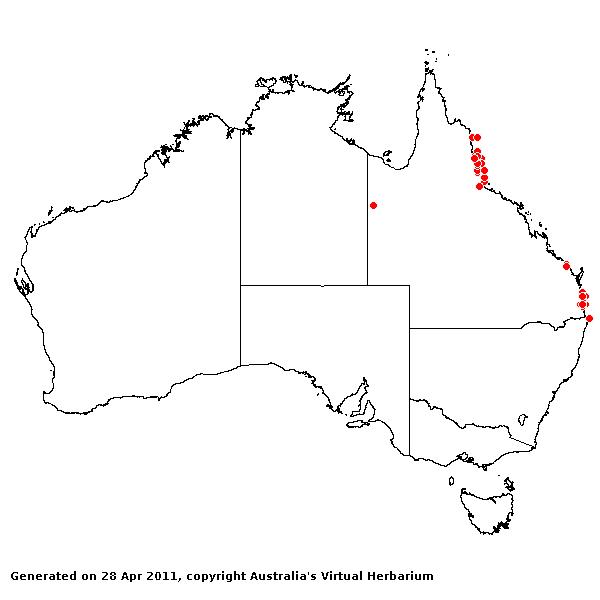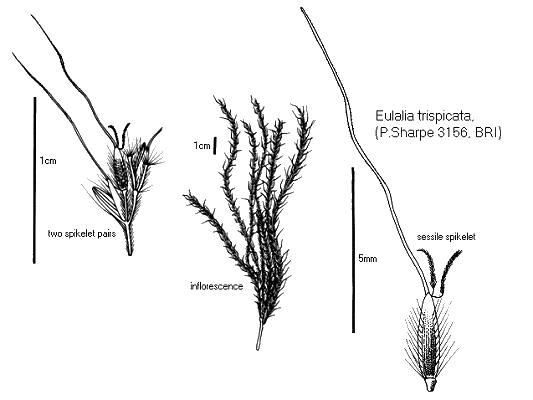Eulalia trispicata (Schult.) Henrard.
Blumea 3: 453 (1940).
Classification. (GPWG 2001) : Subfamily
Panicoideae. Andropogoneae.
Basionym and/or
Replacement Name: Andropogon
trispicatus Schultes, Syst. Veg. 2, Mant. 92 (1831); Mant.
2: 452 (1824), based on A. tristacyos Roxb.
A. tristachyos
Roxb., Fl. Ind. 1: 261 (1820) non Kunth (1816).
Type of Basionym or
Protologue Information: T: India, Roxburgh illustration at K (photo BRI).
Key references
(books and floras): [1878] G.Bentham, Flora Australiensis 7 (527 as Pollinia
tristachya), [2002] D.Sharp & B.K.Simon, AusGrass, Grasses of
Australia.
Habit.
Perennial. Culms erect, 30–130 cm tall. Mid-culm nodes glabrous. Lateral
branches simple. Ligule a fringed membrane, a ciliate membrane, 0.1 mm long.
Leaf-blades 4–35 cm long, 1–5 mm wide. Leaf-blade surface glabrous.
Inflorescence.
Inflorescence digitate, with ramose branches. Rhachis fragile at the nodes.
Spikelets.
Spikelets sessile and pedicelled, 2 in the cluster. Companion spikelets
developed. Fertile spikelets 2-flowered, the lower floret barren (rarely male),
the upper fertile, comprising 1 basal sterile florets, comprising 1 fertile
floret(s), without rachilla extension, linear or lanceolate or elliptic,
dorsally compressed, 3.5–4 mm long.
Glumes. Glumes
dissimilar, firmer than fertile lemma. Lower glume linear or lanceolate or
oblong, coriaceous, much thinner above, keeled, 2-keeled, 3 -nerved. Lower
glume surface indumented. Upper glume oblong, 1–3 -nerved. Upper glume surface
indumented. Upper glume apex muticous. Florets. Basal sterile florets 1,
barren, without significant palea. Lemma of lower sterile floret 100 % of
length of spikelet, hyaline, 0 -nerved.
Fertile lemma 1.5 mm
long, without keel. Lemma apex lobed, awned, 1 -awned. Median (principal) awn
from a sinus, 7–15 mm long overall, with a twisted column. Palea absent.
Anthers 3.
Continental
Distribution: Temperate Asia, Tropical Asia, and Australasia.
Australian
Distribution: Queensland.
Queensland:
Cook, Moreton, North Kennedy, Wide Bay, Burke.
Notes. Coastal
sandy soils of southern and northern Qld, extending through New Guinea, Malesia
and SE Asia to Sri Lanka. Flowers Dec.--July.



